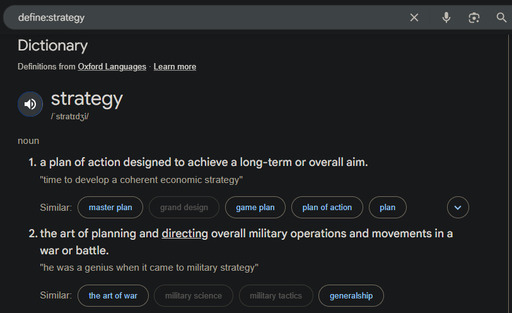 One thing many strategists seem to love to debate is the nature of strategy. What is strategy? What is the difference between strategy and planning? etc.
One thing many strategists seem to love to debate is the nature of strategy. What is strategy? What is the difference between strategy and planning? etc.
As a strategist myself, I find some of these debates interesting, some tedious, and some just plain wrong-headed and unhelpful.
But what I have noticed is that business leaders seldom care!
What they do care about is:
- How do I achieve my aspirations?
- How do I solve my problems?
Examples of these include:
- How do we grow the business?
- How do we prepare for an uncertain future?
- How do we respond to potential threats?
- How do I get my team on the same page and working together?
- How do we execute effectively?
- How do we know if it is all working?
- How do we change course, and when do we need to?
If you can answer those questions, they're unlikely to care whether you call it strategy or not!
But if we are going to talk about strategy, we probably need a definition.
What is Strategy?
The dictionary is a good source for definitions.
 The Oxford English Dictionary defines a strategy as:
The Oxford English Dictionary defines a strategy as:
a plan of action designed to achieve a long-term or overall aim.
I personally prefer a slightly simpler version made up of three components:
A strategy is a plan to achieve a goal within a given context.
Let's look at each of those components.
Goal
A strategy needs some sort of goal - something about the world that you desire to be different. If everything were already exactly the way you wanted it, you wouldn't need a strategy.
Human nature being what it is, that is never the case. We always want something. And if and when we get it, we inevitably want something more.
Choosing and defining the right goal is vital. If you're chasing the wrong goal, then achieving it will be a hollow victory. Organisations sometimes skip this step at their peril. They assume the goals is clear and agreed and don't realise that different people are chasing different goals until (too) late in the process.
The challenge is usually ranking the goals to determine which are primary and which are secondary - or which are the ends and which are the means to those ends.
So, while strategy only needs one goal, it invariably confronts a system of interrelated goals of various levels of importance as well as cause-and-effect relationships.
In business strategy, the overarching goal is typically expressed as a mission, vision or purpose statement. Other words used for goal include objective, aspiration or aim. Many strategists (and systems like StratNav) distinguish and define relationships between these different expressions of goals for convenience.
Plan
Just wanting something (to achieve a goal) is not enough. You need a plan of action to do so.
Whilst most plans entail change, a plan to maintain stasis, like keeping a ship on course, also counts as a plan.
Whilst every strategy involves a plan, a plan on its own (without a goal and context) does not constitute a strategy.
The plan outlines who will do what and by when (and, by extension, what won't be done). It is used to allocate budget and resources. And because plans seldom go as anticipated, the plan must be actively managed and adjusted.
The notion of developing a plan as part of a strategy is called strategic planning.
Other words used to describe plans include policy and rule (about what will/won't or should/shouldn't be done).
In strategy, plans are flexible. They exist to achieve the goal. So if they fail to achieve the goal, the thinking about how best to achieve the goal changes, or the goal itself changes, then the plan also changes.
Context
Often, when people talk about strategy, they really mean business strategy. But business is only one context within which we can talk about strategy.
There is an almost infinite variety of other contexts in which strategy can take place.
For example, we have:
- Military strategy,
- Economic strategy
You can also have a strategy for getting fit, losing weight, or competing in a sporting event. See, for example: Five things running taught me about business strategy and Trust in the process.
And let's not forget that the origins of the word "strategy" itself have their roots in a military context. Perhaps this is because military battles were one of the first arenas in which large numbers of people had to work together to achieve a common goal.
The context of business strategy includes things like markets and regulators, and deals with things like customers, products and services, suppliers and distributors, financing, etc.
Even within business strategy, there are several sub-contexts, often described as layers. And so we have, for example:
- Corporate strategy: which deals with business entities which wholly or partly own or control a number of businesses.
- Business strategy: which deals with individual businesses which produce and distribute goods and services to customers.
- Functional strategies: which deal with the different functional areas (operations, marketing, human resources, IT, finance, etc.) which make up a business or corporation.
These subcontexts or layers exist in a fractal pattern. As a result, each strategy is made up of sub-strategies, which all have the same basic structure as the parent or super-strategy. For example, each of the functional strategies has the same basic structure as the business strategy it supports. You can read more about the fractal nature of strategy.
There are elements of strategic context which are unique to a particular organisation at a particular point in time. And every strategy should be unique to that unique context. That is why discovering, understanding and analysing the context is such an important element of strategic planning.
Constraints
The context in which strategy takes place is almost always constrained. In business strategy, we have limited resources, and obstacles and challenges to understand, prioritise and overcome.
Different authors have called this different things. Peter Compo talks about the Bottleneck. Richard Rumelt talks about the Crux.
But the challenge remains the same: to achieve the goal(s) within the context, the plan must overcome the constraints.
Constraints also give rise to trade-offs. To achieve one goal, we may have to forego another. In choosing one course of action, we may have to forego others. Trade-offs create value to the extent that the chosen goal or course of action creates more value than the alternatives, given the context and constraints. Trade-offs also allow for many competitors to succeed by making different trade-offs.
What is good strategy?
A lot of what passes for debate about what strategy is is actually debate about what good strategy is.
Sitting on your hands whilst waiting for customers to find you is a business strategy. It's just probably not a very good one, in that it is unlikely to achieve your goal.
If you're going to have a strategy, a good one is better than a bad one.
The challenge with defining what a good strategy is is that it is impossible to know what the outcome will be in advance. All strategy involves risk. The best we can do is mitigate the risks.
There is an infinite variety of theories about how best to do that. New ones emerge all the time. Ones that worked in the past stop working as the world continues to change. Anyone who tells you they have the answer is a charlatan. (That doesn't stop them from selling it, and nor does it stop people from buying it.) The best we can offer is methods that increase your chances of arriving at a better answer.
Some red herrings
Strategy is an often misunderstood and abused term. So much so that it is worth considering some of the more common misconceptions.
Strategy versus tactics
Strategy is often described as what you want to do as opposed to tactics which is how you do it. Whilst this is linguistically convenient, it does not stand up to scrutiny.
How do you separate what from how other than by arguing that what describes the goal or outcome and how describes the plan? And as we've already established, the goal is only a part of the strategy, as is the plan!
Another distinction made is that each strategy is made up of tactics. However, as we've seen, the fractal nature of strategy is that each strategy is made up of sub-strategies which are structurally identical to the parent strategy. For a strategy to be made up of tactics, strategy and tactics would need to be essentially the same thing, but seen from different perspectives.
A better distinction is to define tactics as individual configurations or actions from which a strategy may be composed. For example, an army may be trained to perform a wide range of tactical manoeuvres, and the general creates a strategy by selecting which of those tactics should be applied to most effectively achieve the military goal within the given context. In a business context, there may be many available social media tactics from which a marketing strategist selects the combination that will most effectively achieve the organisation's goals. In summary, tactics are the sum total of all actions which an organisation could execute, whilst strategy is the subset of tactics which an organisation chooses as the best way to achieve its goal(s) within the context.
Strategy versus execution
The debate between strategy and execution is often expressed in pithy fallacies like "execution trumps strategy".
But, strategy versus execution is a false dichotomy - something presented as a choice when no such choice exists.
After all, what would you execute other than a strategy? What is a strategy other than something you intend to execute?
We can easily talk about developing a strategy, reviewing a strategy, aligning behind a strategy, and executing a strategy. Execution is something you do to or with a strategy. Execution and strategy are not two things that exist independently of each other.
Strategy versus culture
Strategy versus culture is another false dichotomy. It exists most commonly in the saying, falsely attributed to W. Edwards. Deming, that "Culture eats strategy for breakfast".
The culture that exists within an organisation is part of the context within which it plans to achieve its goals. But it is not fixed. Many strategies include steps to change, develop or improve the organisation's culture to better support its ability to achieve its goals.
There is no choice to be made between the two. Both exist and are important. Each acts on the other. If you insist on the misconception that "Culture eats strategy for breakfast", then you will have to accept that "without strategy, culture will starve."
Strategy as long-term planning
It is easy to see why strategy is often thought of as long-term planning (and by extension, why tactics are sometimes thought of as short-term planning).
When talking about strategy, the goals tend to be quite substantial (some even describe them as "big hairy audacious goals" or BHAGs). They don't have to be, of course, but small, simple and easily achieved goals tend to warrant less discussion. Substantial goals, on the other hand, tend to take substantial efforts over sustained time periods to achieve them. The fact that the context tends to change during that period adds further complications which need to be addressed.
So, strategy does tend to be long-term, but it doesn't have to be. After all, if you could find a way to achieve your so-called long-term goals more quickly - even immediately - you surely would! It's equally true that not all long-term plans are strategic. If they lack appropriate goals and context, they won't be strategic, no matter how long they take to execute.
Strategy is complicated
Strategies that are 'clever' are often considered more strategic than those that rely on brute force (size, amount of spend and effort, etc.). Complexity should not be mistaken for cleverness, and great strategies are often deceptively simple.
Strategies can be good, that is, likely to achieve the goal even as the environment changes around it, or poor, that is, unlikely to achieve the goal and/or too static in the face of the changing environment.
Good strategy often requires a thorough analysis of the goals and context as well as the development and evaluation of many options (alternative plans). The process of developing and executing the strategy may entail significant hard work and complexity, and yet the strategy developed may still be simple.
Strategy is goal-setting
Strategy does involve setting goals. But goal-setting alone is not enough.
Strategy also requires a plan outlining who will do what to overcome the constraints inherent in the context to achieve the goal(s).
And that plan must be both executable and executed.
Strategic Questions
Strategy is often boiled down to three simple questions:
- Where are we now? (Part of the context)
- Where do we want to go? (The goal)
- What is the best way to get there? (The plan)
Of course, in practice, many other questions are likely to arise in answering these. For example:
- What obstacles are we likely to encounter along the way? (More of the context)
- How can we best use the advantages we have or find along the way? (More of the context)
- How is this changing and likely to change as we go?
Ultimately, however, strategy must ask and answer any and all questions needed to achieve the goal.
